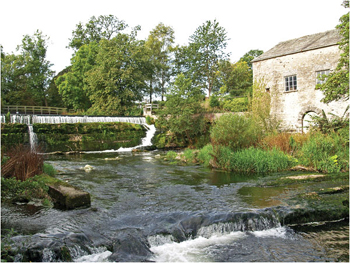Water power secures future of historic watermill

The future of an 18th Century mill has been put on a more secure footing thanks to a 21 Century take on water power.
Lancaster University Engineers have helped to devise and install a low head hydro turbine at the Heron Corn Mill, Beetham, Cumbria, providing enough electricity to supply the historic building and, more importantly, a surplus to sell to the neighbours.
Around 100 KW of electricity can now be pumped out of the turbine and then shared between the Heron Corn Mill and the Paper Mill on the opposite bank of the river.
Heron Corn Mill on the banks of the River Bela, is one of the few working mills in the area, and has been a base for local industry powered by renewable energy for over 900 years. The current building dates from the 1740s to grind corn for flour and animal feed. It ceased to be used commercially in the 1950s.
The Grade II*listed structure comprising the attached mill race, grain kiln/dryer and internal machinery are of national significance – a rare example of a relatively intact, operational, 18th Century corn mill. But the costs of maintaining and renovating such an important building far exceeded income from visitor numbers and its future as an important national heritage site hung in the balance.
Working with Lancaster University Renewable Energy Group, The Heron Corn Mill managers began looking for a way to harness the natural power of the river and turn around the fortunes of the building.
The University, with funding from the Joule Centre and the Northwest Regional Development Agency (NWDA), has recently completed a study looking at the various barriers to the deployment of small scale hydro power and was perfectly placed to offer advice to the Mill.
George Aggidis, Director of the Lancaster University Renewable Energy Group, said: “In the past we have used water power to drive our industry and process our food, but through the 20th Century it fell out of fashion as coal, mineral oil and natural gas became abundant and cheap and electricity became a popular transmitter of power.
“As fossil fuels start to show signs of running out, become increasingly expensive and are blamed for significant environmental damage, people are starting to look for clean sources of power.
“Water still flows through our landscapes and energy can be extracted from it, but why is it not being more widely taken up?
“We found there is not one single barrier but a number of different obstacles so we have developed an online tool kit to help people asses their options and find a way through those obstacles.
“The Heron Corn Mill hydropower turbine is an excellent example of what can be achieved. ”
Audrey Steeley, Project Development Manager at the Heron Corn Mill, said: “This is an important historical building and a fascinating visitor attraction complete with a working fourteen-foot high waterwheel.
“But in order to complete our restoration project we needed to secure another income stream. The income from the electricity generated by the turbine puts the mill on a much more sustainable footing and is enabling us to bring in a whole new audience.”
The online toolkit, which can guide the user through the questions about using small scale hydro and point to the experts where necessary, is available on the LUREG website: http://www.lancs.ac.uk/fas/engineering/lureg/nwhrm/.
To watch a time-lapse video of the Heron Corn Mill turbine installation go to: http://www.heronmill.org/cam.shtml